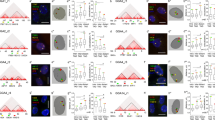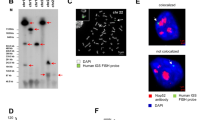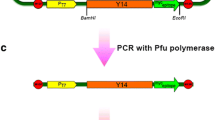Abstract
The cell nucleus comprises a number of chromatin-associated domains. Certain chromatin-associated domains are nucleated by nascent RNA and accumulate non-nascent transcripts in the form of ribonucleoprotein (RNP) aggregates. In the transcriptionally active nucleus of the growing avian oocyte, RNP-rich structures, here termed giant terminal RNP aggregates (GITERA), form at the termini of lampbrush chromosomes. Using GITERA as an example, we aimed to explore mechanisms of RNP aggregate formation at certain chromosomal loci to establish whether they accumulate non-nascent RNA and to analyze protein composition in RNP aggregates. We found that GITERA on chicken and pigeon lampbrush chromosomes do not contain nascent transcripts. At the same time, RNA fluorescent in situ hybridization (FISH) and in situ reverse transcription demonstrated that GITERA accumulate poly(A)-rich RNA. Moreover, subtelomere chromosome regions adjacent to GITERA are transcriptionally active as shown by detection of incorporated BrUTP and the elongating form of RNA polymerase II. GITERA on both chicken and pigeon lampbrush chromosomes are enriched in splicing factors but not in heterogeneous nuclear RNP (hnRNP) L and K. A subtype of GITERA concentrates hnRNP I/PTB and p54nrb/NonO. Interestingly, hnRNP I/PTB and p54nrb/NonO in such subtype of GITERA were revealed in long threads. The resemblance of these threads to amyloid-like fibers is discussed. Our data suggest that transcription of subtelomeric sequences serves as a seeding event for accumulation of non-nascent RNA and associated RNP proteins. Such accumulation leads to GITERA formation in terminal chromosomal regions in avian oocyte nucleus. 3′-processed transcripts derived from other chromosomal loci may be attracted to GITERA by binding to the same RNP proteins or to their interaction partners.









Similar content being viewed by others
Abbreviations
- FISH:
-
Fluorescent in situ hybridization
- FUS:
-
Fused in sarcoma
- GITERA:
-
Giant terminal RNP aggregates
- hnRNP:
-
Heterogeneous nuclear RNP
- ISRT:
-
In situ reverse transcription
- mAb:
-
Monoclonal antibody
- PSF/SFPQ:
-
PTB-associated splicing factor/splicing factor proline- and glutamine-rich
- p54nrb/NonO:
-
nuclear RNA-binding protein/non-POU domain-containing octamer-binding protein
- PTB:
-
Polypyrimidine tract-binding protein
- RNase A:
-
Ribonuclease A
- SC35:
-
Splicing component (factor) 35 kDa
References
Batalova FM, Bogolyubov DS, Parfenov VN (2010) Interchromatin granule clusters of the scorpionfly oocytes contain poly(A) + RNA, heterogeneous ribonucleoproteins A/B and mRNA export factor NXF1. Cell Biol Int 34:1163–1170
Bellott DW, Skaletsky H, Pyntikova T, Mardis ER, Graves T, Kremitzki C, Brown LG, Rozen S, Warren WC, Wilson RK, Page DC (2010) Convergent evolution of chicken Z and human X chromosomes by expansion and gene acquisition. Nature 466:612–616
Bond SC, Fox AH (2009) Paraspeckles: nuclear bodies built on long noncoding RNA. J Cell Biol 186:637–644
Bubulya PA, Prasanth KV, Deerinck TJ, Gerlich D, Beaudouin J, Ellisman MH, Ellenberg J, Spector DL (2004) Hypophosphorylated SR splicing factors transiently localize around active nucleolar organizing regions in telophase daughter nuclei. J Cell Biol 167:51–63
Calado A, Tomé FM, Brais B, Rouleau GA, Kühn U, Wahle E, Carmo-Fonseca M (2000) Nuclear inclusions in oculopharyngeal muscular dystrophy consist of poly(A) binding protein 2 aggregates which sequester poly(A) RNA. Hum Mol Genet 15:2321–2328
Carter KC, Taneja KL, Lawrence JB (1991) Discrete nuclear domains of poly(A) RNA and their relationship to the functional organization of the nucleus. J Cell Biol 115:1191–1202
Chelysheva LA, Solovei IV, Rodionov AV, Yakovlev AF, Gaginskaya ER (1990) The lampbrush chromosomes of the chicken. The cytological map of macrobivalents. Tsitologiia 32:303–316
Chen F, Gonzalez JM, Dustman WA, Morgan MA, Hodson RE (1997) In situ reverse transcription, an approach to characterize genetic diversity and activities of prokaryotes. Appl Environ Microbiol 63:4907–4913
Deryusheva S, Krasikova A, Kulikova T, Gaginskaya E (2007) Tandem 41-bp repeats in chicken and Japanese quail genomes: FISH mapping and transcription analysis on lampbrush chromosomes. Chromosoma 116:519–530
Dreyfuss G, Matunis MJ, Pinol-Roma S, Burd CG (1993) hnRNP proteins and the biogenesis of mRNA. Annu Rev Biochem 62:289–321
Gaginskaya ER (1972) Nuclear structures in oocytes of adult birds. II. Protein bodies and the karyosphere. Tsitologiia 14:568–578
Gaginskaya E, Kulikova T, Krasikova A (2009) Avian lampbrush chromosomes: a powerful tool for exploration of genome expression. Cytogenet Genome Res 124:251–267
Garber JC, Wayne Barbee R, Bielitzki JT et al (2011) Guide for Care and Use of the Laboratory Animals. The National Academic Press, Washington
Guang S, Felthauser AM, Mertz JE (2005) Binding of hnRNP L to the pre-mRNA processing enhancer of the herpes simplex virus thymidinekinase gene enhances both polyadenylation and nucleocytoplasmic export of intronless mRNAs. Mol Cell Biol 25:6303–6313
Hall LL, Smith KP, Byron M, Lawrence JB (2006) Molecular anatomy of a speckle. Anat Rec A: Discov Mol Cell Evol Biol 288:664–675
Hori T, Suzuki Y, Solovei I, Saitoh Y, Hutchison N, Ikeda JE, Macgregor H, Mizuno S (1996) Characterization of DNA sequences constituting the terminal heterochromatin of the chicken Z chromosome. Chromosome Res 4:411–426
Huang S, Deerinck TJ, Ellisman MH, Spector DL (1997) The dynamic organization of the perinucleolar compartment in the cell nucleus. J Cell Biol 137:965–974
Jolly C, Lakhotia SC (2006) Human sat III and Drosophila hsrω transcripts: a common paradigm for regulation of nuclear RNA processing in stressed cells. Nucleic Acids Res 34:5508–5514
Kato M, Han TW, Xie S, Shi K, Du X, Wu LC, Mirzaei H, Goldsmith EJ, Longgood J, Pei J, Grishin NV, Frantz DE, Schneider JW, Chen S, Li L, Sawaya MR, Eisenberg D, Tycko R, McKnight SL (2012) Cell-free formation of RNA granules: low complexity sequence domains form dynamic fibers within hydrogels. Cell 149:753–767
Khodyuchenko T, Gaginskaya E, Krasikova A (2012) Non-canonical Cajal bodies form in the nucleus of late stage avian oocytes lacking functional nucleolus. Histochemistry Cell Biol 138:57–73
Khutinaeva MA, Kropotova EV, Gaginskaia ER (1989) The characteristics of the morphofunctional organization of the lampbrush chromosomes from the oocytes of the rock dove. Tsitologiia 10:1185–1192
Kim HJ, Kim NC, Wang YD, Scarborough EA, Moore J et al (2013) Mutations in prion-like domains in hnRNPA2B1 and hnRNPA1 cause multisystem proteinopathy and ALS. Nature 495:467–473
Krasikova AV, Gaginskaia ER (2010) Organization of centromere regions of chromosomes in the lampbrush phase. Tsitologiia 52:515–533
Krasikova A, Kulikova T, Saifitdinova A, Derjusheva S, Gaginskaya E (2004) Centromeric protein bodies on avian lampbrush chromosomes contain a protein detectable with an antibody against DNA topoisomerase II. Chromosoma 113:316–323
Krasikova A, Khodyuchenko T, Maslova A, Vasilevskaya E (2012) Three-dimensional organization of RNA-processing machinery in avian growing oocyte nucleus. Chromosome Res 20:979–994
Kropotova EV, Gaginskaya ER (1984) Lampbrush chromosomes from the Japanese quail oocytes. Tsitologiia 26:1008–1015
Lerner MR, Andrews NC, Miller G, Steitz JA (1981) Two small RNAs encoded by Epstein–Barr virus and complexed with protein are precipitated by antibodies from patients with systemic lupus erythematosus. Proc Natl Acad Sci U S A 78:805–809
Macgregor HC (2012) Chromomeres revisited. Chromosome Res 20:911–924
Mankodi A, Teng-Umnuay P, Krym M, Henderson D, Swanson M, Thornton CA (2003) Ribonuclear inclusions in skeletal muscle in myotonic dystrophy types 1 and 2. Ann Neurol 54:760–768
Mao YS, Sunwoo H, Zhang B, Spector DL (2011) Direct visualization of the co-transcriptional assembly of a nuclear body by noncoding RNAs. Nat Cell Biol 13:95–101
Matunis MJ, Michael WM, Dreyfuss G (1992) Characterization and primary structure of the poly(C)-binding heterogeneous nuclear ribonucleoprotein complex K protein. Mol Cell Biol 12:164–171
Meissner M, Lopato S, Gotzmann J, Sauermann G, Barta A (2003) Proto-oncoprotein TLS/FUS is associated to the nuclear matrix and complexed with splicing factors PTB, SRm160, and SR proteins. Exp Cell Res 283:184–195
Pinol-Roma S, Swanson MS, Gall JG, Dreyfuss G (1989) A novel heterogeneous nuclear RNP protein with a unique distribution on nascent transcripts. J Cell Biol 109:2575–2587
Politz JC, Tuft RA, Prasanth KV, Baudendistel N, Fogarty KE, Lifshitz LM, Langowski J, Spector DL, Pederson T (2006) Rapid, diffusional shuttling of poly(A) RNA between nuclear speckles and the nucleoplasm. Mol Biol Cell 17:1239–1249
Prasanth KV, Prasanth SG, Xuan Z, Hearn S, Freier SM, Bennett CF, Zhang MQ, Spector DL (2005) Regulating gene expression through RNA nuclear retention. Cell 123:249–263
Rushizky GW, Knight CA, Sober HA (1961) Studies on the preferential specificity of pancreatic ribonuclease as deduced from partial digests. J Biol Chem 236:2732–2737
Rushizky GW, Knight CA, Roberts WK, Dekker CA (1962) Studies on the mechanism of action of micrococcal nuclease. II. Degradation of ribonucleic acid from tobacco mosaic virus. Biochim Biophys Acta 55:674–682
Saifitdinova A, Derjusheva S, Krasikova A, Gaginskaya E (2003) Lampbrush chromosomes of the chaffinch (Fringilla coelebs L.). Chromosome Res 11:99–113
Sallacz NB, Jantsch MF (2005) Chromosomal storage of the RNA-editing enzyme ADAR1 in Xenopus oocytes. Mol Biol Cell 16:3377–3386
Schwartz JC, Wang X, Podell ER, Cech TR (2013) RNA seeds higher-order assembly of FUS protein. Cell Rep 5:918–925
Shen W, Liang XH, Crooke ST (2014) Phosphorothioate oligonucleotides can displace NEAT1 RNA and form nuclear paraspeckle-like structures. Nucleic Acids Res 42:8648–8662
Shevtsov SP, Dundr M (2011) Nucleation of nuclear bodies by RNA. Nat Cell Biol 13:167–173
Solovei I, Gaginskaya E, Hutchison N, Macgregor H (1993) Avian sex chromosomes in the lampbrush form: the ZW lampbrush bivalents from six species of bird. Chromosome Res 1:153–166
Solovei I, Gaginskaya ER, Macgregor HC (1994) The arrangement and transcription of telomere DNA sequences at the ends of lampbrush chromosomes of birds. Chromosome Res 2:460–470
Solovei I, Macgregor H, Gaginskaya E (1995) Single stranded nucleic acid binding structures on chicken lampbrush chromosomes. J Cell Sci 108:1391–1396
Solovei IV, Joffe BI, Gaginskaya ER, Macgregor HC (1996) Transcription on lampbrush chromosomes of a centromerically localized highly repeated DNA in pigeon (Columba) relates to sequence arrangement. Chromosome Res 8:588–603
Trofimova I, Popova D, Vasilevskaya E, Krasikova A (2014) Non-coding RNA derived from a conservative subtelomeric tandem repeat in chicken and Japanese quail somatic cells. Mol Cytogenet 7:1–13
Uversky VN, Kuznetsova IM, Turoverov KK, Zaslavsky B (2015) Intrinsically disordered proteins as crucial constituents of cellular aqueous two phase systems and coacervates. FEBS Lett 589:15–22
Wang J, Cao LG, Wang YL, Pederson T (1991) Localization of pre-messenger RNA at discrete nuclear sites. Proc Natl Acad Sci U S A 88:7391–7395
Yamazaki T, Hirose T (2014) The building process of the functional paraspeckle with long non-coding RNAs. Front Biosci (Elite Ed) 7:1–47
Acknowledgments
We are grateful to Ulrich Scheer (University of Wuerzburg, Germany) for kindly providing mAb V22. We also would like to thank Svetlana Deryusheva (Carnegie Institution for Science, USA) for helpful methodological advises. RNP composition analysis was supported by the Russian Science Foundation (grant #14-14-00131); poly(A)-RNA distribution analysis was supported by the grant of the President of Russia (grant #NS-3553.2014.4). The work was partially performed using experimental equipment of the Research Resource Centers “Chromas” and “Molecular and Cell Technologies” of St. Petersburg State University.
Author information
Authors and Affiliations
Corresponding author
Ethics declarations
Conflicts of interest
The authors declare that they have no competing interests.
Ethical approval
This article does not contain any studies with human participants performed by any of the authors. All applicable international, national, and/or institutional guidelines for the care and use of animals were followed.
Electronic supplementary material
Below is the link to the electronic supplementary material.
ESM 1
(PDF 147 kb)
Rights and permissions
About this article
Cite this article
Kulikova, T., Chervyakova, D., Zlotina, A. et al. Giant poly(A)-rich RNP aggregates form at terminal regions of avian lampbrush chromosomes. Chromosoma 125, 709–724 (2016). https://doi.org/10.1007/s00412-015-0563-4
Received:
Revised:
Accepted:
Published:
Issue Date:
DOI: https://doi.org/10.1007/s00412-015-0563-4




